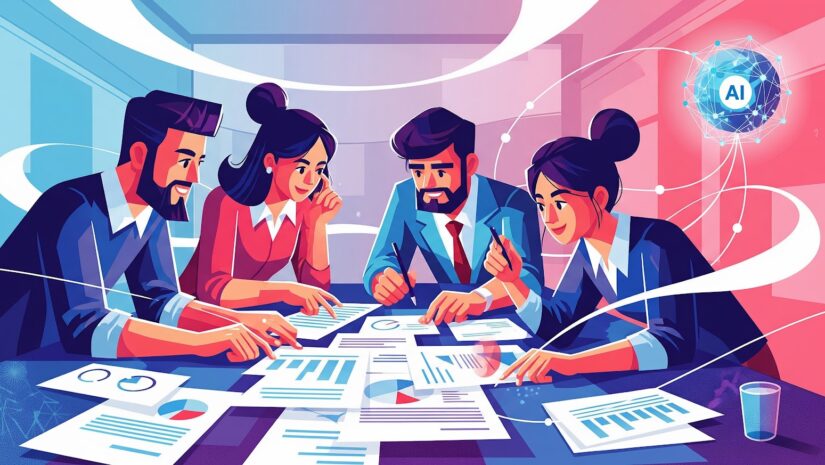Like many other qualitative researchers around us, Stby is actively experimenting with the use of AI tools in our work. This is an ongoing endeavour that started late 2022 when ChatGPT stormed on stage, and we’ve kept it up since then, while many new tools emerged and have been further developed.
We are particularly interested in what the use of AI means for collaborative teamwork. Both in our client work and our R&D, this is an ever-evolving subject that goes far beyond individual use of AI as a productivity tool. One of the apps we use most frequently at the moment is Notebook LM. In this article, we’ll share some of our experiences and learnings.
For those unfamiliar with Notebook LM, this is an AI-powered tool developed by Google as part of the Google Workspace suite. It allows users to upload documents, and interact with them conversationally, asking questions, generating summaries and exploring connections based on the uploaded content. Importantly, the data stays private within our secure online business account, ensuring that all the information we use remains exclusive to our organisation.
In this reflection, we offer a glimpse into our journey of using Notebook LM for a recent client project, while highlighting the moments where AI was a delight and where its limitations became apparent. The project entailed transforming a long-form 200+ report into more actionable and transferable knowledge products. We developed a new interactive information structure and a series of custom content formats. Early on in the process, we were curious to explore what role Notebook LM could play for us and how it might serve as a collaborator in this intensive content-driven process.
Crunching volumes of data into key insights
During the initial phases, Notebook LM proved to be a helpful collaborator. As we familiarised ourselves with the long-form report, the tool assisted us in filtering information and generating shortened versions of the text aligned with a custom framework we had developed. This provided a strong starting point and saved us the time and energy of manually extracting and organising the data.
In addition to the long-form report, Notebook LM also helped summarise hours of recorded workshop discussions into digestible summaries within minutes. This ability to condense large amounts of data quickly allowed us to focus our energy on analysis and design.
This phase in the project sparked some interesting reflections and positive learnings:
When faced with the challenge of navigating large volumes of data, collaborating with AI helps us to work more efficiently as a team
When iteration demands more than AI can deliver
As the project progressed, our needs evolved. The early summaries were useful, but deeper iteration required us to return to the original text. The AI-generated outputs lacked the nuance, accuracy, and contextual understanding that our later stages demanded. What worked for broad overviews fell short when we needed precision and deeper understanding of the content in the report to reach applicable insights.
We realised that while AI can produce content, it often struggles with tasks requiring interpretation, judgement, and nuanced understanding. We also recognise that the human brain cannot just take a piece of text and claim knowledge and understanding. Text generated by AI couldn’t replicate the iterative and dynamic conversations we routinely have with human collaborators to deepen our understanding of complex interpretive information.
This phase sparked another, more contrasting series of reflections and learnings:
When working on very precise iterations and refinements, AI contributions reach their limits, and it stops being a collaborator
Building personas with AI
As we moved into the stage of developing hypothetical persons for our knowledge product, we turned again to Notebook LM. Here, it surprised us. It wasn’t just summarising information, it was weaving together data from various documents to suggest plausible, relatable scenarios. We were surprised by its creativity when it brought together different elements in the form of a persona. This gave us a starting point (pretty high quality one) to refine our personas and helped shape a consistent format for describing them. This moment showcased one of AI’s strengths: combining various sources into coherent starting points for creative and strategic thinking.
This phase again sparked new reflections and learnings:
When generating new content across various sources, AI can be surprisingly creative and inspiring
Reflections on AI as a collaborator
As we wrap up the project, we are reflecting on what it means to collaborate with AI. Treating AI as a full-fledged collaborator has its challenges. Unlike human collaborators, it doesn’t have intuition, real-life experience, or the ability to sense what’s unspoken. It can’t always anticipate our needs or help us shape the outcomes the way a human collaborator intuitively could. There were moments of frustration, too many prompts led to confusion (a learning curve for us humans!), and we often had to restart or reframe the interaction altogether.
Yet, through this experience, we found clarity in Notebook LM’s role in our team. It’s a great collaborator in specific roles: as a note-taker, a processor of large volumes of information, and a source of inspiration. It suggests new formats, synthesises ideas quickly, and helps broaden our perspective. But it’s not a substitute for human expertise, contextual awareness, or the seamless navigation of complex platforms and shifting project goals that we take for granted as humans.
In conclusion
Our journey with AI has been one of learning and adaptation. We’ve found Notebook LM a valuable collaborator when involved with intention and clear expectations. For analysing large volumes of text-based data, AI speeds up the process dramatically, not as a replacement for human collaborators, but as an assistive presence. It can enhance efficiency, support creativity, and surface connections, but collaboration, sense making, and strategic decision making remain very human tasks.
Riya Gokharu & Qin Han
